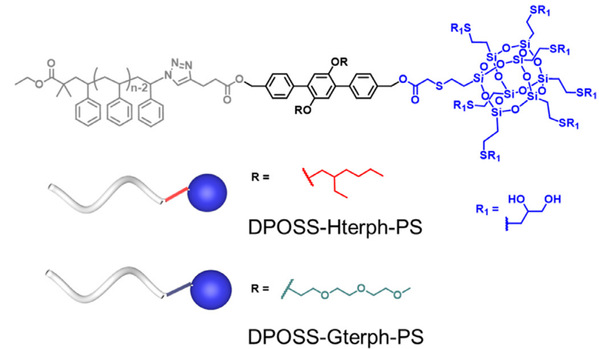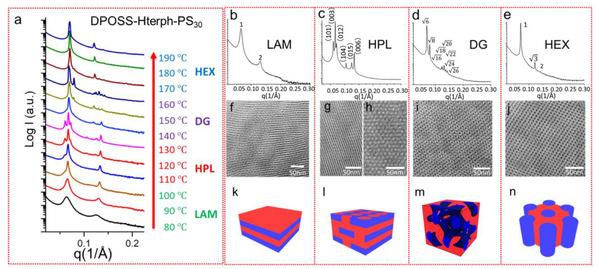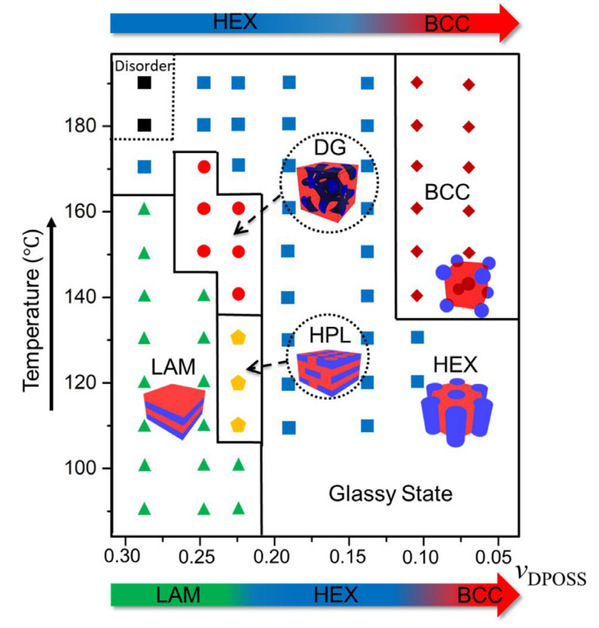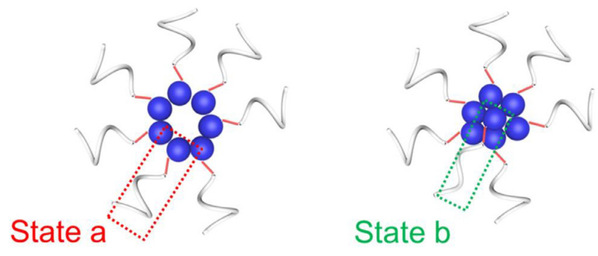The structure of materials has great influence on their property, which leads to the extensive self-assembly structures of macromolecules for several decades, including block polymers, dendrimers and giant molecules. Interestingly, the self-assembly behavior of giant molecules is not only dependent on composition, χN value (χ is the Flory-Huggins interaction parameter and N is the total degree of polymerization), temperature and volume fraction for traditional block polymers, but also influenced much more greatly by the cross-section area, linkers, sequence and topologies.
Recently, a work about the influence of interfacial structure and temperature on self-assembly structures has been published in Giant by the team of South China Advanced Institute for Soft Matter Science and Technology (AISMST) from South China University of Technology (SCUT) collaborated with the team from McMaster University. They designed and synthesized two classes of giant surfactans with hydrophilic and hydrophobic linkers respectively. Such attempt of interface engineering has achieved on the manipulation of the self-assembly behavior. The self-assembly structures of giant surfactans with hydrophilic linkers DPOSS-Gterph-PSn are similar to the giant surfactants DPOSS-PSn where there is no observation of order-order phase transitions (OOTs), but the giant surfactans DPOSS-Hterph-PSn with hydrophobic linkers do have the phenomenom of order-order phase transition. This work highlights the importance of the property in interface on the self-assembly behavior for giant molecules whose principles obtained from current study could also be applied to the self-assembly of other amphiphilic molecules.
Firstly, the team synthesized two classes of giant surfactants with the DPOSS with 14 hydroxyl groups as the head and the hydrophobic polystyrene as the tail. The linker used here is the rigid para-terphenyl segment decorated with hydrophobic 2-ethylhexyl (DPOSS-Hterph-PSn) or hydrophilic triethylene glycol (DPOSS-Gterph-PSn) groups. By adjusting the length of PS, the volume fractions of DPOSS heads (VDPOSS) are varied from 0.07 to 0.29 for both series of samples.

Fig. 1. Molecular structures and schematics of DPOSS-Hterph-PSn and DPOSS-Gterph-PSn (blue ball represents DPOSS, red rod represents the terphenyl segment with hydrophobic side groups and cyan rod represents the terphenyl segment with hydrophilic side groups).

Fig. 2 Structure characterization of DPOSS-Hterph-PS30(a) In-situ synchrotron SAXS data during temperature ramp; (b-e) Room temperature SAXS patterns after thermal annealing at 100 °C, 120 °C, 150 °C and 180 °C, respectively, and (f-j) the corresponding BF TEM images of microtomed thin slices; (k-n) the schematics of the ordered phases corresponding to LAM, HPL, DG and HEX.
An example of complex OOTs was provided by the sample of DPOSS-Hterph-PS30 (VDPOSS = 0.23), which exhibited the most complicated phase behavior. When the temperature was increased at a rate of 5 °C/min between two steps and isothermal annealing for 20 min at each step, four different ordered structures were observed (Fig. 2a). Initially, a LAM phase was found in a temperature range between 80 °C and 100 °C (a d-spacing of 9.67 nm). As a comparison, it was observed that the LAM period or d -spacing of the analogous DPOSS-PS30 was 8.70 nm. When the temperature was increased to the region between 110 °C and 130 °C, the LAM phase transformed to a hexagonally perforated layer structure (HPL). When further increasing the temperature to the region between 140 °C and 160 °C, the phase structure of sample changed to a DG phase. Above 170 °C, the DG structure transferred into a HEX structure.

Fig. 3 In-situ synchrotron SAXS data at different temperatures for (a) DPOSS-Hterph-PS20 , (b) DPOSS-Hterph-PS26 , (c) DPOSS-Hterph-PS60 and (d) DPOSS-Hterph-PS80 .
Varying the molecular weight of the PS tail resulted in different thermotropic OOTs. For example, DPOSS-Hterph-PS20 (VDPOSS = 0.29) showed a LAM to HEX transition at 170 °C (Fig. 3a); DPOSS-Hterph-PS26 (VDPOSS = 0.25) exhibited a LAM to DG transition at 150 °C, followed by a DG to HEX transition at 180 °C (Fig. 3b). For these three lower molecular weight samples, they all have phase transitions from LAM to HEX structure, whereas with different OOT pathways. When the molecular weight of PS was increased, samples of DPOSS-Hterph-PS40 (VDPOSS = 0.19) and DPOSS-Hterph-PS60 (VDPOSS = 0.14) only exhibited HEX phases. When continuously increasing the molecular weight of PS to DPOSS-Hterph-PS132 (VDPOSS = 0.07), only a BCC structure was observed in the whole temperature region. Surprisingly, no OOT was observed in all the DPOSS-Gterph-PSn samples, an analogous series with hydrophilic side groups attached on the rigid segment.

Fig. 4. Morphological phase diagram of DPOSS-Hterph-PSn. The colored dots represent experimentally accessed data points. The black lines represent the phase morphological boundaries. The arrows at the top and the bottom represent the structure changes with varying composition at high temperature and at lower temperature, respectively.

Fig. 5 Two different states of rigid segments in giant surfactants system.
To understand the temperature-dependences of OOTs in these giant surfactants, we proposed a simplified two-state model to describe the behaviors of the rigid segments. As showed in Fig.5, the rigid segments in a giant surfactant could assume two possible states: in state (a), the segment does not penetrate the hydrophilic DPOSS part; in state (b), the segment is inserted into the DPOSS domain. Pa is the possibility of the segments remaining in the hydrophobic PS domain, and Pb is the possibility that the segments dissolving themselves into the hydrophilic DPOSS domain. The higher energy of the state (a) and the state (b), the lower value of Pa and Pb. For the molecules DPOSS-Hterph-PSn, the state (b) with hydrophobic segments in hydrophilic DPOSS domain is with high energy and the molecules would adopt the state (a) with lower energy. When the temperature is increased, the molecules DPOSS-Hterph-PSn have acquired more energy and more hydrophobic segments insert into the DPOSS domain, which means Pb is increased too and thus there are order-order transitions. For the molecules DPOSS-Gterph-PSn with hydrophilic segments, they would adopt the state (b) because the hydrophilic segments like the hydrophilic DPOSS domain regardless of the temperature.
Fine-tuned order-order phase transitions in giant surfactants via interfacial engineering
Wenpeng Shan, Wei Zhang, Mingjun Huang, Yuyang Ji, Ruimeng Zhang, Rui Zhang, Zebin Su, Hao Liu, Xueyan Feng, Dong Guo, Jiahao Huang, Tong Liu, Tao Li, Jialin Mao, Chrys Wesdemiotis, An-Chang Shi, Stephen Z.D. Cheng
Giant 2020, 1, 100002
https://doi.org/10.1016/j.giant.2020.100002
